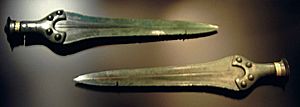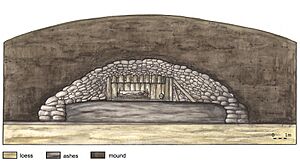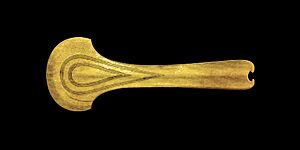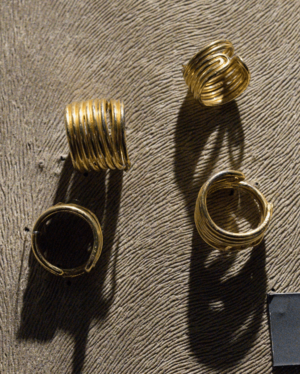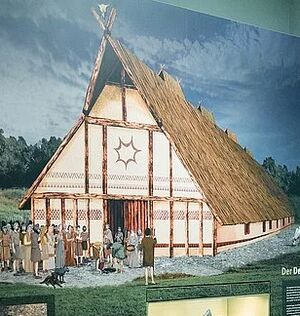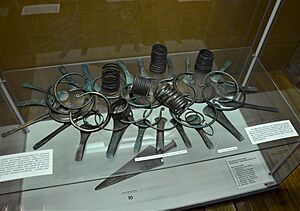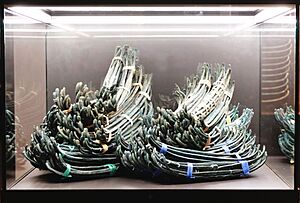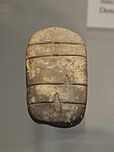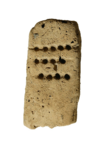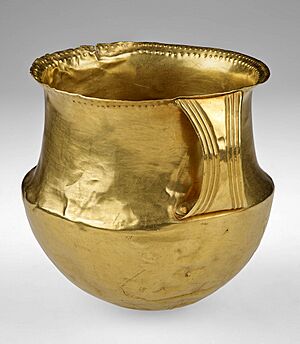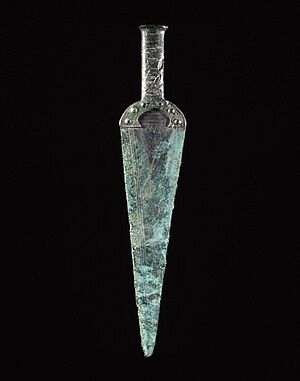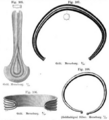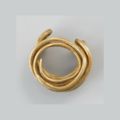Únětice culture facts for kids
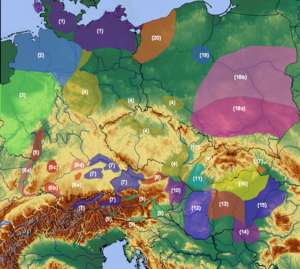 |
|
| Geographical range | Europe |
|---|---|
| Period | Early Bronze Age |
| Dates | c. 2300–1600 BC |
| Type site | Únětice |
| Preceded by | Bell Beaker culture, Corded Ware culture |
| Followed by | Tumulus culture, Nordic Bronze Age, Mad'arovce culture, Trzciniec culture |
The Únětice culture (say: Oon-yeh-TEE-tseh) was an important group of people living in Central Europe during the early Bronze Age. This was a long time ago, from about 2300 BC to 1600 BC. The culture is named after a village called Únětice in the Czech Republic, near Prague. Many places where these people lived have been found across the Czech Republic, Slovakia, Poland, and Germany. You can also find traces of them in parts of Austria and Ukraine.
Contents
Discovering the Únětice Culture

People started learning about the Únětice culture in the late 1800s. A Czech surgeon and amateur archaeologist named Čeněk Rýzner found a burial ground with over 50 graves in Únětice in 1879. Around the same time, other burial sites were found in different areas.
In Germany, a special grave for a leader was found in Leubingen in 1877. Later, many more Únětice sites were discovered across Central Europe. Archaeologists like Hans Seger in Poland and Józef Kostrzewski helped uncover many important finds, including large burial sites.
Over time, experts created a timeline to understand the different stages of the Únětice culture. We now know that this culture had a big impact across Europe. Their pottery and bronze items have been found far away, from Ireland to Scandinavia! This shows they traded a lot and had connections with many other groups.
Timeline of the Únětice People
The Únětice culture existed during the Early Bronze Age. Archaeologists divide this time into two main periods:
- Early Period (2300–1950 BC): People used triangular daggers, flat axes, and stone wrist-guards.
- Later Period (1950–1700 BC): They started making daggers with metal handles, axes with raised edges, and special pins.
Where the Únětice People Lived
The Únětice culture first appeared in what is now the Czech Republic. Over time, they spread out, and archaeologists have found ten different local groups. These groups lived in places like Moravia, Slovakia, parts of Germany, and Poland. Each group had its own small differences, but they all shared the main Únětice ways of life.
Amazing Finds and How They Lived
Burials and Graves
The Únětice people buried their dead in two main ways: in flat graves or under large mounds called barrows. They usually buried bodies, but sometimes they also cremated them (burned the bodies).
Their cemeteries were often near their villages, usually on a hill or rise, close to a stream or river. The graves were often arranged in neat rows. It seems they even used the stars and the sun to decide how to place the bodies, which shows they knew a lot about astronomy!
Princely Graves
More than 50 large Únětice burial mounds have been found in Central Europe. These are often called "princely graves" because they were for important leaders. The biggest one was the Bornhöck mound in Germany, built around 1800 BC. It was huge, about 65 meters (213 feet) wide and 15 meters (49 feet) tall! It was even covered with white limestone, which was unusual for the area. This mound likely belonged to a powerful ruler, perhaps connected to the famous Nebra sky disk.
Another large mound is Barrow No. 4 at Łęki Małe in Poland, which is 50 meters (164 feet) wide today. These large graves show that some people in the Únětice society were very important and powerful.
Gold Weapons and Treasures
Amazing gold items have been found in these princely graves. For example, a gold axe and jewelry were found in Dieskau, Germany. A gold dagger was also found in Poland. These gold weapons show how rich and powerful some of these leaders were. Similar gold weapons have been found in other parts of Europe from the same time, showing a network of important people.
Flat Graves
Most Únětice people were buried in flat graves. These were rectangular or oval pits. The bodies were almost always placed in a north-south direction, with the head facing south and looking east. The body was usually slightly bent.
Everyone, no matter their age or gender, was buried in the same way. They were often buried with pottery (usually 1-5 pots), bronze jewelry, and tools made of bone or flint. Sometimes, the bodies were protected with mats or even wooden coffins.
Metal Objects and Trade
The Únětice culture is famous for its special metal objects. These include twisted metal rings (torcs), flat axes, triangular daggers, and pins. These items have been found all over Central Europe and even further away.
Archaeologists have found many hoards (hidden collections) of these metal items. Some hoards have hundreds of pieces! Axes might have even been used as a form of money. After 2000 BC, bronze production grew a lot, and tin bronze became very common. Special weapons and ornaments were made for important people.
The famous Nebra sky disk is linked to the Únětice culture in Germany. The gold and tin used to make this disk came from far away, like England and Austria! This shows how much they traded.
Settlements and Homes
The Únětice people lived in houses made of wood. They had gabled roofs (like an upside-down V) and were rectangular. The roofs were likely thatched (made of straw or reeds), and the walls were built using a technique called wattle and daub (woven branches covered with mud).
A common feature of their settlements were deep storage pits under their houses. These pits were often used to store grain. Most villages had several houses grouped together. Some larger villages were even fortified with walls and wooden defenses, like Bruszczewo in Poland. These bigger villages might have been important centers for trade and politics.
Around 2300 BC, large circular enclosures were built in central Germany, like at Pömmelte. These were important places for ceremonies and rituals. The largest Early Bronze Age settlement in Central Europe was built next to the Pömmelte enclosure, with remains of 130 large timber houses! Some Únětice buildings were incredibly long, like the Dermsdorf longhouse (44 meters long!). These might have been homes for leaders, meeting halls, or even places for groups of warriors.
Trade and Money
The Únětice culture traded with groups far away, like the Wessex culture in Britain. They were skilled metalworkers, using pure copper and alloys (mixtures) of copper with other metals to make bronze. Tin from Cornwall in England was traded widely. Even gold items from Ireland have been found in Germany, showing how far their trade networks reached. Amber was also a popular trade item.
Weights and Early Money
Archaeologists have found that many bronze rings, ribs, and axe blades from this time had similar weights. This suggests they might have been used as an early form of money! As time went on, people started using lighter metal pieces, showing that they were becoming more precise with trade.
In 2014, a huge hoard of copper rib-ingots was found in Oberding, Germany. It had 796 ingots! Most were tied in bundles of ten, with each ingot weighing about 100 grams. This shows they used a decimal system (counting in tens), which is very interesting for such an ancient time.
Mysterious Clay Tablets
Many mysterious clay tablets, sometimes called Brotlaibidole (meaning "bread-loaf idols"), have been found at Únětice sites and other places in Europe. These tablets have strange patterns of circles, lines, and dots. No one knows for sure what they were for, but many think they were used for long-distance trade, maybe for keeping track of metals. They are often found broken in half, which could mean they were like a receipt or a way to keep track of debts.
Social Life and Leaders
Around 2000 BC, the Únětice society became more complex. There were powerful leaders, almost like princes, who were in charge. These leaders were supported by armed groups. This is shown by the rich graves, large hoards of metal, and the big buildings they constructed. They also produced a lot of food and controlled trade. The creation of the Nebra Sky Disc is another sign of their advanced society and powerful leaders.
The Únětice Calendar
The large circular enclosures, like the one at Pömmelte, were built in a special way. Their entrances lined up with the sunrise and sunset at important times of the year, like midway between the longest and shortest days. This suggests they were used for ceremonies related to the seasons and the calendar. These dates are similar to later Celtic festivals that celebrated harvests and seasonal changes.
The Pömmelte enclosure is very similar in size and design to Stonehenge in Britain, which was also used as a calendar. This might mean that the people who built them shared similar ideas about the world.
The Nebra sky disk is thought to be the oldest clear picture of astronomical events in the world. It probably helped people combine the solar (sun) and lunar (moon) calendars to create a very accurate calendar. The stars on the disk might represent the Pleiades, a star cluster used as "calendar stars" in ancient times. The gold arcs on the disk show the angle of the sun at different times of the year. This amazing disk allowed the Únětice leaders to predict things like lunar eclipses, which would have shown their power and knowledge.
Únětice Culture's Big Impact
The Únětice culture was a very important part of early Bronze Age Europe. It was a dynamic and expanding group of people. Their influence spread widely because they traded so much. Únětice pottery and bronze items have been found in places like Britain, Ireland, Scandinavia, and Italy.
Their metalworking and pottery styles influenced many other groups in Germany, Switzerland, and Austria. Some archaeologists even see these other groups as local versions of the larger Únětice culture. The Únětice culture truly helped shape what Bronze Age Europe became.
Images for kids
-
Bronze halberd, Poland
-
Bronze artefacts from the Nebra sky disc deposit
See also
- Deposit finds of the Aunjetitz culture
- Bronze Age Britain
- Wessex culture
- Armorican Tumulus culture
- Nordic Bronze Age
- Argaric culture
- Rhône culture
- Sintashta culture
- Catacomb culture
- Abashevo culture
- Ottomány culture
- Wietenberg culture
- Polada culture
- Cetina culture
- Castellieri culture
- Helladic culture
- Mycenaean Greece
- The Collection of Pre- and Protohistoric Artifacts at the University of Jena


